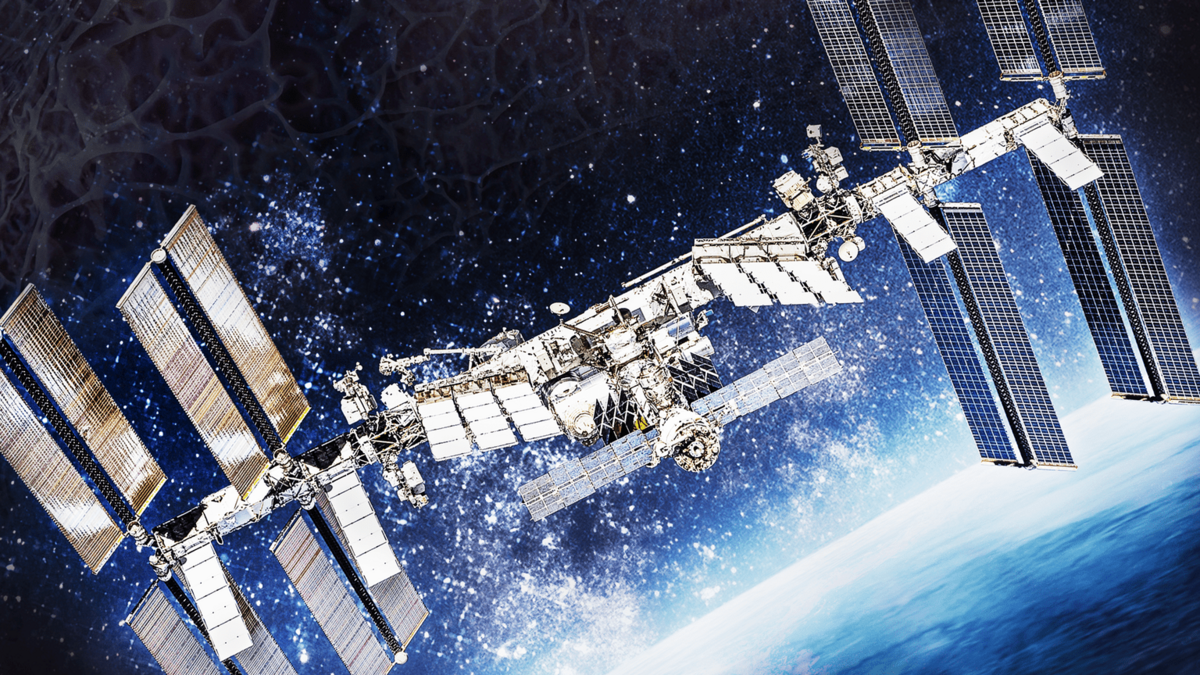Cosmic currents: Preserving water quality for astronauts during space exploration

The International Space Station is an orbiting oasis of science and multicountry unity. On Nov. 9, the SpaceX Falcon rocket streaked skyward from Kennedy Space Center in Florida, bound for the International Space Station to investigate Escherichia coli and Pseudomonas aeruginosa — two microbial pathogens that could potentially pose a risk to astronauts and spaceflight systems due to the aggregation of these bacteria into sticky residues known as biofilms. Graphic by Jason Drees
On Nov. 9, the SpaceX Falcon rocket streaked skyward from Kennedy Space Center in Florida, bound for the International Space Station (ISS). The rocket is on a commercial resupply mission dubbed CRS-2 SpX-29. In addition to providing vital provisions for astronauts, SpX-29 carries a special biological sciences payload — a collaborative experiment developed by researchers at Arizona State University, Texas State University (TSU) and NASA to study how spaceflight affects bacterial growth and biofilm formation in life support systems on the ISS.
This experiment will provide scientists with information to help improve spacecraft habitat sustainability — specifically, protection of one of the most vital and vulnerable resources aboard any space vehicle: water.
The results from this study will provide critical insights for future spacecraft design, life support systems operations and crew health. Controlling biofilms, sticky communities of microbes that adhere to surfaces, is critical to protect the integrity of life support systems that provide water that is safe for drinking and personal hygiene.
The research also promises to shed light on the subtleties of bacterial behavior under reduced gravity conditions, as well as bacterial activities here on Earth, many of which remain poorly understood.
The two model pathogenic microorganisms featured in the study, Escherichia coli and Pseudomonas aeruginosa, have been detected in the past aboard the ISS, and both are associated with causing biofilms in water lines. Limiting or eliminating such bacterial pathogens from the water supply is essential for the health and safety of the crew as well as the integrity of mission-critical systems during spaceflight.
In a series of groundbreaking experiments, Cheryl Nickerson (co-principal investigator, ASU), Robert McLean (principal investigator, TSU) and their colleagues explore the risk of biofilm formation on stainless steel surfaces like those in the ISS water system, the potential for system corrosion, and the effectiveness of microbial disinfection in order to validate the results of their earlier spaceflight research.
“We are honored that NASA selected our team’s research for a rare reflight opportunity to the International Space Station,” Nickerson says. “This provides us the chance to validate the results from our previous flight study to understand and control the impact of the spaceflight environment on interactions between microbes and their habitat. It also reflects the importance of this work to NASA’s goals to protect human health and habitat sustainability in spaceflight.”
Cheryl Nickerson
Biodesign researcher Jiseon Yang, a contributor to the new mission, says, "Understanding the resilience of multispecies biofilms is important to ensure the health of astronauts and the durability of life support systems during extended space travel. This research aims not only to support the success of future deep space exploration but also provides profound implications for water treatment and corrosion control on Earth."
Nickerson is a professor with the School of Life Sciences and a researcher in the Biodesign Center for Fundamental and Applied Microbiomics at Arizona State University.
Nickerson and McClean are joined by co-investigators Jennifer Barrila (assistant research professor, ASU) and C. Mark Ott (lead microbiologist, NASA Johnson Space Center), as well as Jiseon Yang (assistant research Professor, ASU), Richard Davis (ASU), Sandhya Gangaraju (ASU), Taylor Ranson (Texas State University), Starla Thornhill (NASA JSC) and Alistair McLean.
The project is a unique collaboration between ASU, TSU and NASA, and represents one of the few cases of joint funding between NASA’s Space Biology and Physical Sciences divisions.
Space germs and their threat
The new study, dubbed BAC (for bacterial adhesion and corrosion), will investigate two spaceflight hazards associated with microbially contaminated drinking water. The first is a health threat to the spaceflight crew, caused by E. coli and P. aeruginosa, both potent biofilm formers, which can cause disease at high enough concentrations. Since bacteria in biofilms are known to be resistant to disinfectants and antibiotics, it makes them difficult to remove and treat. This is important given that the rigors of spaceflight depress the immune system and some pathogens increase their disease-causing potential in spaceflight. This means that space travelers are potentially more susceptible to infectious disease.
The second concern is a safety threat, since microbial biofilms in water can be corrosive, degrading essential components and compromising spaceflight systems over time.
The project is a rare opportunity for researchers to double-check results of their previous BAC spaceflight study from 2020 and further fine-tune recommendations for ensuring continuous availability of safe water in space.
As NASA and other organizations contemplate longer and more complicated endeavors in space, including return voyages to the moon and potential trips to Mars, the issue of water integrity during spaceflight is more pressing than ever. Any water-related mishap during extended spaceflight is a potentially lethal emergency.
Water: Vessel of illness and health
Here on Earth, contaminated water is the source of many life-threatening infectious diseases, including cholera, typhoid fever, enteric salmonellosis and dysentery. A complex infrastructure has been constructed to ensure the water we are exposed to is safe.
During spaceflight, however — far from the comfort of our home planet — the importance of safeguarding this precious resource becomes even more critical, and the challenges far more daunting.
Water resources in space are tracked carefully, including the recycling, purification and reuse of urine, wastewater and even sweat. Despite the extravagant lengths taken to ensure water aboard the ISS is safe, bacterial microbes are tenacious foes and will try to find a footing in water supplies or on material surfaces, where they can multiply. Different types of bacteria can join forces to create aggressive biofilms that are resistant to efforts to eradicate them with antimicrobials.
Lab in the sky
The experiments will track the growth of E. coli and P. aeruginosa within specially designed containers over a 117-day period aboard the ISS. The study will evaluate the formation of biofilms when the two pathogens are combined, which is relevant to how biofilms naturally develop in mixed populations. The tests will evaluate bacterial biofilm development during an early, middle and late phase over the course of the spaceflight.
Additionally, some of the biofilms will be exposed to silver disinfectant, to see how well this addition acts to limit growth and biofilm formation. The results will help guide NASA’s future decisions for microbial control of water resources using silver in the water systems as opposed to iodine, which is the current anti-microbial of choice.
The researchers will also examine biofilm formation on stainless-steel materials like those used in the ISS water system to see whether biofilm formation is acting to corrode them. A final evaluation explores bacterial gene expression during spaceflight, shedding light on how microgravity and other spaceflight conditions may be guiding bacterial behavior at the molecular level.
Challenges for safe water
Aboard the ISS, the Environmental Control and Life Support System uses an advanced process to purify water. This intricate procedure starts with a primary filtration step to sift out particles and detritus. Following this treatment, the water flows through layers of multi-filtration beds, which are designed to absorb and eliminate both organic and inorganic contaminants. The final stage eradicates volatile organic substances and exterminates any microorganisms present.
Even with such advanced life-support mechanisms in place to safeguard the water supply, bacterial populations have proven adept at circumventing these barriers, with some establishing resilient biofilms within the ISS water purification system.
Biofilms present significant global socioeconomic challenges, leading to extensive health and industrial issues, with financial repercussions soaring into billions of dollars annually here on Earth. They are responsible for clogging oil and chemical processing lines, contaminating invasive medical devices like stents, triggering infections and polluting water supplies. Furthermore, biofilms can aggressively corrode numerous materials, including stainless steel, which is a component of the ISS water system, thereby jeopardizing its integrity.
Although the ISS water harbors many of the same microorganisms that are present in terrestrial drinking water, conditions in space raise worries that these microorganisms could become more dangerous. One specific concern is related to the effects of microgravity — a factor that researchers from the same team have found to potentially increase the harmfulness and stress tolerance of certain pathogens.
Alterations of bacterial genes under spaceflight conditions could lead to a better understanding of how biofilms develop with translational potential to control biofilms on Earth and in space. Such investigations further underscore the value of space-based platforms for gaining new insights in life and health sciences.
More Science and technology

ASU and Deca Technologies selected to lead $100M SHIELD USA project to strengthen U.S. semiconductor packaging capabilities
The National Institute of Standards and Technology — part of the U.S. Department of Commerce — announced today that it plans to…

From food crops to cancer clinics: Lessons in extermination resistance
Just as crop-devouring insects evolve to resist pesticides, cancer cells can increase their lethality by developing resistance to…

ASU professor wins NIH Director’s New Innovator Award for research linking gene function to brain structure
Life experiences alter us in many ways, including how we act and our mental and physical health. What we go through can even…
